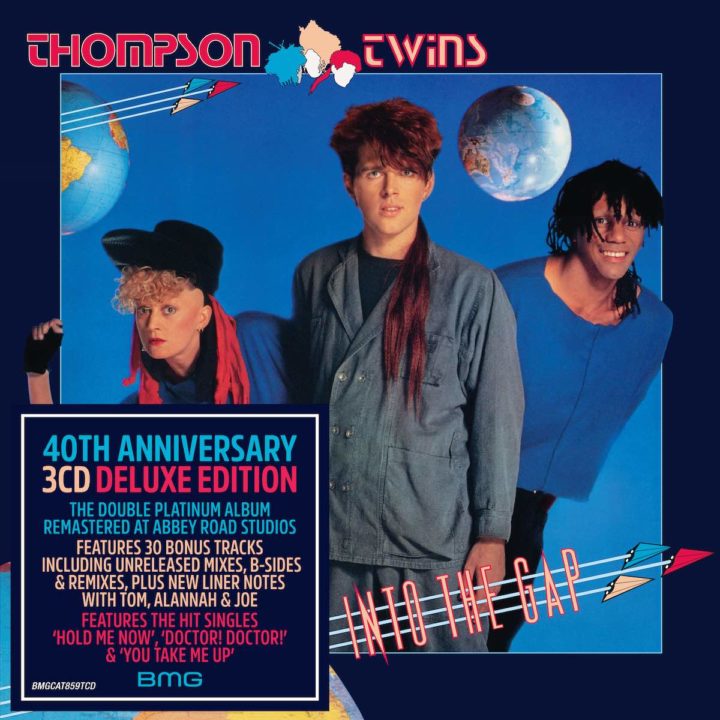
In our exclusive Thompson Twins interview, Tom Bailey, Alannah Currie and Joe Leeway share their story together after nearly 40 years…
Pioneers who were a riot of colour and mischief, the group were only ever going to blaze brightly for a brief time. Two of them have left music behind for decades, while Tom Bailey only returned after years away from pop. Here the trio reveal how squats, Grace Jones and fire extinguishers helped create a transatlantic phenomenon.
Before we go any further, let’s make one thing clear: Thompson Twins are not getting back together. And when Classic Pop was told that all three Twins would be up for talking about the 40th anniversary of their sole No.1 album, Into The Gap, we were happily stunned.
Now an artist, Alannah Currie has spoken to us just once about her pop life, back in 2017, moving away from music altogether since her final album with Tom Bailey as Babble in 1996. Joe Leeway is even more distant from pop – a therapist in California for 20 years, Joe hasn’t been on stage since 1986, when he rejoined Thompson Twins for one show in L.A., a year after quitting the group. Leeway doesn’t seem to have publicly spoken about music once in the intervening 38 years. Yet here they all are.
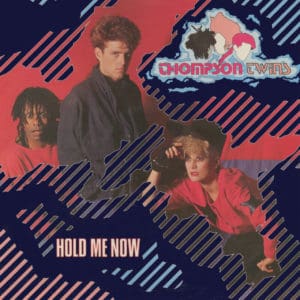
Designers Of Pop
Across two Zoom interviews, plus Leeway by phone, the band all speak with genuine warmth and a little bemusement that they managed to be international pop stars for a couple of years.
But getting back on stage together? Currie sums up the mood best: “We are all old,” she laughs. “We’re grandparents, nearly 70. It’s nice that people still enjoy our songs. But doing more Thompson Twins? No. I’m very much of the belief that things have their time.
“I don’t go to see bands who I loved 20 years ago, because part of the joy of live performance is in the potential, in artists who quiver with the feeling of: ‘What are they going to do next?’ We felt old after Into The Gap – and we probably were. We were 30 then. Who wants to know anybody over 30 in pop music? Ugh! Other people came along and took over. We’d had our time.”
It’s a happily irreverent attitude that entirely fits Thompson Twins’ original ethos. Tom describes their intentions to become “designers of pop music”, rather than a regular band, after the initial seven-piece line-up made two inventive but chaotic albums, A Product Of and Set.
Breaking All The Rules
“It was a different band with different aims and objectives,” notes Bailey. “It was very much a band of musicians, where every song had to find a role for the two guitarists, the bassist and so on. That all ended on Quick Step & Side Kick, when I said: ‘No rules anymore.’ Probably partly unconsciously, we broke down the assumptions that a band had to be four white guys standing there. Once it was me, Alannah and Joe, our records didn’t have to be anything, apart from good songwriting and good recording.”
Although 1983’s third LP Quick Step & Side Kick and its hits including Love On Your Side and We Are Detective lived up to their grand pop designs, the trio’s background was anything but pop. Like Bananarama, Bronski Beat and Culture Club, Thompson Twins 2.0 formed via London’s squatting community. Joe and Tom met at college in Sheffield, where Bailey remembers them “hanging out at the snack bar, waffling nonsense away at each other.” They lost contact, reuniting when Leeway was working at The Young Vic theatre in London.
Joe recalls: “I was living in a bedsit in Fulham and met Alannah at a party. She said: ‘There’s a squat opposite me.’ Within a week, I had a whole cottage opposite Alannah in South London.” Currie takes up the story: “Joe told me that he had mates in a band who were moving down to London. The next thing, Thompson Twins turned up in their van from Sheffield. Joe was really flamboyant and theatrical, full of crazy ideas. Tom was very quiet, a quite serious person. We were great friends for a year before getting it together as boyfriend and girlfriend.”
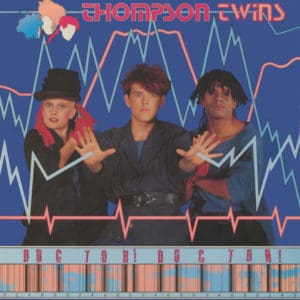
Can’t You See I’m Burning
Initially becoming the band’s roadie, Leeway told Bailey that he “quite fancied playing bongos and congas,” while Alannah tried one writing session with the original line-up, but remembers: “There were too many people, too many ideas. I just thought: ‘This is a nightmare.’”
“The squatting community enabled the band,” enthuses Joe. “Not paying rent, you could use the money for rehearsals instead. Next door to us, at any one time you’d find The Slits or Rip Rig + Panic. The downside was that we couldn’t get served in the pub, as the tabloid perception was that squatters were all heroin addicts. The world thought we were disgusting, but we had independence.”
Once the line-up was slimmed down to a trio who didn’t need to have instrumental parts written for them in every song, Quick Step & Side Kick initially established Thompson Twins as an electronic trio. “I can’t believe how easy it was to write pop music then,” laughs Tom. “I find it more difficult to write pop now. Perhaps you run out of the most obvious ideas. You learn more tricks the more songs you write but, particularly around Into The Gap, it felt effortless. We were a good team, which peaked on that record.”
With Bailey in charge of music, Currie taking care of lyrics and videos, and Leeway overseeing the live shows, they soon became a workaholic co-operative, not even choosing to take Christmas Day off. Alannah recalls: “Our songs came from storytelling. The three of us would get together to tell stories, gather ideas, then sift through them, editing and editing. After Quick Step & Side Kick, I understood that the song found you as much as you found it. We played with humour a lot, taking quite complex ideas and translating them into little nuggets of pop.”
Pioneering Trio
Having not been together in almost 40 years, it’s now overlooked just how pioneering Thompson Twins were. Alannah is still a rarity, as a female musician writing lyrics for a male singer, in a band who were male/female and of mixed ethnicity. The trio were so forward-thinking and forward-looking that Currie admits there were suspicions they’d been assembled by a record company. She says: “We were completely who we were: three utter misfits and weirdos. Somehow, it worked. Being brilliant mates helped, as we got off on each other’s fun and influences.”
Joe adds: “We were a perfect combination: one black, two white, with red, yellow and black hair. We could speak to different cultures. I’m pretty sure I was the first musician to have cultural dreadlocks, that I was the first who wasn’t a reggae person.”
The Twins’ look was immortalised by veteran sleeve designer Andie Airfix, who created the trio’s cartoon logo, based around their multi-coloured hair. “Pop music has to have a lightness and ease to it,” considers Tom. “It has to be easily absorbable and consumable. Andie’s three cartoon heads logo was a success the same way The Rolling Stones had their lips. It doesn’t sum up the band, but it gives you a way into it. I’ve seen lots of people with the logo tattooed on their arm at my tour, which is remarkable.”
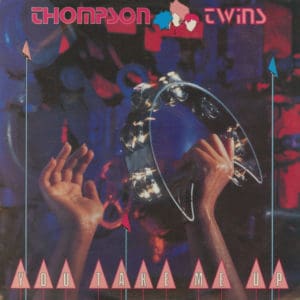
You Take Me Up
After Quick Step & Side Kick had reached No.2, kept off the top by Thriller, the trio were given the perfect foundation for what came next with Hold Me Now, a make-up ballad written in just 25 minutes after a row between Bailey and Currie. “Everyone agreed: ‘Wow, you’ve got a hit song there!’,” smiles Tom. “There’s a lot of hubris and bravado around pop groups, so we took that with a pinch of salt. In this case, it turned out to be true.”
Thompson Twins were helped in their pop quest by producer Alex Sadkin. Hired for his work with Bob Marley and Grace Jones, he was the perfect foil to hone their anarchic side. “A nice man, very calm,” reflects Alannah. “Alex was instrumental in helping us get our sound together, as he was musically very open. He asked what I was going to do and I told him that I wanted to play a fire extinguisher. His response was: ‘Fine with me, let’s get the fire extinguishers out.’ Alex made us sound so cool. We didn’t sound anything like Grace Jones, but that was Alex: he took the best of everyone and put it together for them.”
Into The Gap saw the previous album’s all-electronic ethos disappear, broadening their sound by bringing analogue instruments back. “We’d got a foot in America,” explains Bailey. “We noticed there was still a big rocktastic flavour in American tastes, with pure synth-pop still rejected. They wanted more of a classic rock sound. Adding a few guitars was part of the realisation we needed to broaden our audience in America. You’ve got to stick to your guns, but we allowed ourselves that freedom, having been more rigid on Quick Step & Side Kick.”
Top Of The Pops
The resulting success was starting to feel natural, as Leeway says: “The first time we did Top Of The Pops, we were shocked that anyone was waiting outside for us. Within a couple of years, going on TOTP was as familiar as going round your gran’s house. It was the same with travel. I’d never been on a plane before we went to the Bahamas to first work with Alex. Growing into that life, becoming more confident, allowed us to do more.”
Having a band member in charge of their concerts helped Thompson Twins’ arena shows become a foretaste of modern pop spectacles. “We were always theatrical,” Joe emphasises. “Our key thought was: ‘What’s the deal with pop?’ Well, pop is about image, and that translated into our live show’s spectacle. They were an event, with spotlights and searchlights. I wanted people to feel desperate for us to come to their town.”
Leeway believes that the Twins’ invincibility first faded when they didn’t appear on Band Aid. Their management simply didn’t inform the band, then living in France, that it was happening. “Obviously we’d have done it if we’d known,” he sighs. “A little decision like that completely upset our momentum in England. Paul Weller called us out, saying: ‘They’re tax exiles, that’s why they didn’t do it.’ The perception was that we were too big for our boots. We did the Band Aid Top Of The Pops, but it wasn’t the same. The horse had already bolted.”
It didn’t help that the trio were creatively burnt out. Currie remembers: “We didn’t have one idea in our brains, but the label wanted us back in the studio after three weeks. We should have said: ‘Go away, see you in six months.’ Instead, we said something pompous like: ‘We’ll write if you hire us a castle in Ireland.’ Suddenly, we were in a castle in Ireland.”
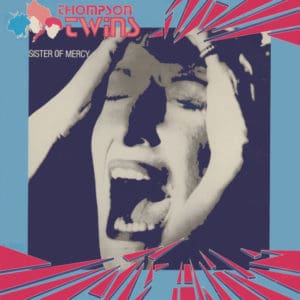
Here’s To Future Days
Alex Sadkin was busy working with Arcadia, so the trio tried producing Here’s To Future Days themselves. Alannah admits: “It wasn’t good enough, so we redid it with Nile Rodgers. He wasn’t the right person but, fundamentally, we didn’t have the songs or the energy.” Tom adds: “I’m sure Nile would agree that, at the time, he was scraping along the barrel of drug and alcohol problems. People were begging me to let Nile off the hook, to give him time to recover. But we were under immense pressure to finish the record, so that wasn’t easy. I still fully enjoyed working with Nile, who’s an extremely sophisticated musician and sophisticated person in general.”
Joe announced he was leaving at the end of the album’s tour: “I tried making music on my own, but it wasn’t the same,” he states. “Thompson Twins was working with friends. When I was with other musicians, it didn’t gel, so I re-educated myself and came back to the real world, where life has worked out for me.”
After what Alannah calls the “terrible” Close To The Bone, Thompson Twins’ final albums as a duo, Big Trash and Queer, are unsung gems in tune with rave culture, before two LPs as Babble were even more hardcore.
With Tom and Joe back in touch thanks to Into The Gap’s reissue and wanting to catch up properly, all three Thompson Twins are happily friends again: Currie and Leeway had remained mates. They might not get to play live any time soon, but their bond as Twins is strong again five decades on. As Joe puts it: “It was only seven years of my life and there are so many other ways to express myself now. But what an experience. The momentum was just incredible. I was plucked into the pop life and all I can say about it is: ‘Thank you very much!’”.
Order Thompson Twins – Into The Gap 40th Anniversary Reissue here
The post Into The Gap – Thompson Twins interview appeared first on Classic Pop Magazine.
